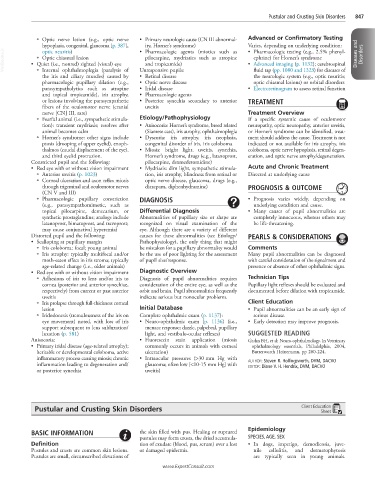Page 1685 - Cote clinical veterinary advisor dogs and cats 4th
P. 1685
Pustular and Crusting Skin Disorders 847
○ Optic nerve lesion (e.g., optic nerve • Primary neurologic cause (CN III abnormal- Advanced or Confirmatory Testing
ity, Horner’s syndrome)
hypoplasia, congenital, glaucoma [p. 387], • Pharmacologic agents (miotics such as Varies, depending on underlying condition:
VetBooks.ir • Quiet (i.e., nonred) sighted (visual) eye pilocarpine, mydriatics such as atropine • Advanced imaging (p. 1132); cerebrospinal Diseases and Disorders
optic neuritis)
• Pharmacologic testing (e.g., 2.5% phenyl-
○ Optic chiasmal lesion
ephrine) for Horner’s syndrome
and tropicamide)
○ Internal ophthalmoplegia (paralysis of
the neurologic system (e.g., optic neuritis;
• Retinal disease
the iris and ciliary muscles) caused by Unresponsive pupils: fluid tap (pp. 1080 and 1323) for diseases of
pharmacologic pupillary dilation (e.g., • Optic nerve disease optic chiasmal lesions) or orbital disorders
parasympatholytics such as atropine • Iridal disease • Electroretinogram to assess retinal function
and topical tropicamide), iris atrophy, • Pharmacologic agents
or lesions involving the parasympathetic • Posterior synechia secondary to anterior TREATMENT
fibers of the oculomotor nerve (cranial uveitis
nerve [CN] III, rare) Treatment Overview
○ Fearful animal (i.e., sympathetic stimula- Etiology/Pathophysiology If a specific systemic cause of oculomotor
tion): transient mydriasis; resolves after • Anisocoria: Horner’s syndrome, breed related neuropathy, optic neuropathy, anterior uveitis,
animal becomes calm (Siamese cats), iris atrophy, ophthalmoplegia or Horner’s syndrome can be identified, treat-
○ Horner’s syndrome: other signs include • Dyscoria: iris atrophy, iris neoplasia, ment should address the cause. Treatment is not
ptosis (drooping of upper eyelid), enoph- congenital disorder of iris, iris coloboma indicated or not available for iris atrophy, iris
thalmos (caudal displacement of the eye), • Miosis: bright light, uveitis, synechia, coloboma, optic nerve hypoplasia, retinal degen-
and third eyelid protrusion. Horner’s syndrome, drugs (e.g., latanoprost, eration, and optic nerve atrophy/degeneration.
Constricted pupil and the following: pilocarpine, dexmedetomidine)
• Red eye with or without vision impairment • Mydriasis: dim light, sympathetic stimula- Acute and Chronic Treatment
○ Anterior uveitis (p. 1023) tion, iris atrophy, blindness from retinal or Directed at underlying cause
○ Corneal ulceration and axon reflex miosis optic nerve disease, glaucoma, drugs (e.g.,
through trigeminal and oculomotor nerves diazepam, diphenhydramine) PROGNOSIS & OUTCOME
(CN V and III)
○ Pharmacologic pupillary constriction DIAGNOSIS • Prognosis varies widely, depending on
(e.g., parasympathomimetic, such as underlying condition and cause.
topical pilocarpine, demecarium, or Differential Diagnosis • Many causes of pupil abnormalities are
synthetic prostaglandins; analogs include Abnormalities of pupillary size or shape are completely innocuous, whereas others may
latanoprost, bimatoprost, and travoprost; recognized on visual examination of the be life-threatening.
may cause conjunctival hyperemia) eye. Although there are a variety of different
Distorted pupil and the following: causes for these abnormalities (see Etiology/ PEARLS & CONSIDERATIONS
• Scalloping at pupillary margin Pathophysiology), the only thing that might
○ Iris coloboma: focal; young animal be mistaken for a pupillary abnormality would Comments
○ Iris atrophy: typically multifocal and/or be the use of poor lighting for the assessment Many pupil abnormalities can be diagnosed
moth-eaten effect in iris stroma; typically of pupil size/response. with careful consideration of the signalment and
age-related change (i.e., older animals) presence or absence of other ophthalmic signs.
• Red eye with or without vision impairment Diagnostic Overview
○ Adhesions of iris to lens and/or iris to Diagnosis of pupil abnormalities requires Technician Tips
cornea (posterior and anterior synechiae, consideration of the entire eye, as well as the Pupillary light reflexes should be evaluated and
respectively) from current or past anterior orbit and brain. Pupil abnormalities frequently documented before dilation with tropicamide.
uveitis indicate serious but nonocular problems.
○ Iris prolapse through full-thickness corneal Client Education
lesion Initial Database • Pupil abnormalities can be an early sign of
○ Iridodonesis (tremulousness of the iris on Complete ophthalmic exam (p. 1137): serious disease.
eye movement) noted, with loss of iris • Neuro-ophthalmic exam (p. 1136) (i.e., • Early detection may improve prognosis.
support subsequent to lens subluxation/ menace response; dazzle, palpebral, pupillary
luxation (p. 581) light, and vestibulo-ocular reflexes) SUGGESTED READING
Anisocoria: • Fluorescein stain application (miosis Grahn BH, et al: Neuro-ophthalmology. In Veterinary
• Primary iridal disease (age-related atrophy); commonly occurs in animals with corneal ophthalmology essentials, Philadelphia, 2004,
heritable or developmental coloboma, active ulceration) Butterworth Heinemann, pp 200-224.
inflammatory process causing miosis; chronic • Intraocular pressures (>30 mm Hg with AUTHOR: Steven R. Hollingsworth, DVM, DACVO
inflammation leading to degeneration and/ glaucoma; often low [<10-15 mm Hg] with EDITOR: Diane V. H. Hendrix, DVM, DACVO
or posterior synechia uveitis)
Pustular and Crusting Skin Disorders Client Education
Sheet
Epidemiology
BASIC INFORMATION the skin filled with pus. Healing or ruptured
pustules may form crusts, the dried accumula- SPECIES, AGE, SEX
Definition tion of exudate (blood, pus, serum) over a lost • In dogs, impetigo, demodicosis, juve-
Pustules and crusts are common skin lesions. or damaged epidermis. nile cellulitis, and dermatophytosis
Pustules are small, circumscribed elevations of are typically seen in young animals.
www.ExpertConsult.com

